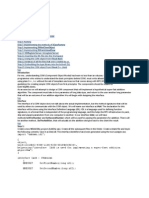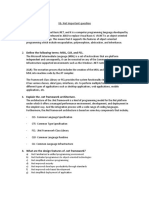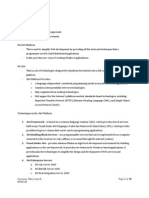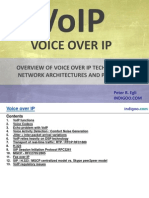Com, Dcom, Com+
Com, Dcom, Com+
Uploaded by
Peter R. EgliCopyright:
Available Formats
Com, Dcom, Com+
Com, Dcom, Com+
Uploaded by
Peter R. EgliOriginal Title
Copyright
Available Formats
Share this document
Did you find this document useful?
Is this content inappropriate?
Copyright:
Available Formats
Com, Dcom, Com+
Com, Dcom, Com+
Uploaded by
Peter R. EgliCopyright:
Available Formats
COM DCOM - COM+
indigoo.com
COM, DCOM,
COM+
OVERVIEW OF MICROSOFTS COM, DCOM AND
COM+ COMPONENT TECHNOLOGIES
Peter R. Egli 2015
Peter R. Egli
INDIGOO.COM
1/20
Rev. 1.60
COM DCOM - COM+
indigoo.com
Contents
1.
2.
3.
4.
5.
6.
7.
8.
9.
10.
11.
12.
13.
Evolution of COM
COM, DCOM, ActiveX, OLE, COM+
Structure of COM Components
(D)COM IUnknown Interface
Component Lookup and Access
Microsoft IDL File
Execution / Access Models
DCOM Architecture
COM/DCOM/COM+ Tools
Access (D)COM Objects from .Net (COM-.Net Interop)
COM+ Applications
Creation of COM Projects in Visual Studio
Limitations of COM
Peter R. Egli 2015
2/20
Rev. 1.60
COM DCOM - COM+
indigoo.com
1. Evolution of COM
Over time Microsoft enhanced and rebranded the
different object and integration technologies.
.Net is a technological break because it
is an entirely new technology.
Object Linking and Embedding.
Based on DDE.
Technology for embedding and
linking of documents in other
documents.
Fusing of COM/DCOM and
MTS plus additional
services.
Uses COM as object
technology.
Renamed part of OLE
related to networking.
The parts of OLE relating
to compound documents
remained OLE.
Distributed COM (COM over
RPC).
Technology with
remotable objects.
Microsofts answer to
CORBA.
COM+
Component Object Model.
Object technology
confined to single machines.
MTS
ActiveX
Dynamic Data Exchange.
One of the first inter-process
communication means in Windows
Technology for compound
documents (e.g. Word document
with embedded Excel
document).
Microsoft Transaction
Server.
Runs on top of
COM/DCOM, but is not really
integrated with these
technologies.
Introduced transaction
management, component
deployment and other
services.
DCOM
COM
OLE
DDE
1987
Peter R. Egli 2015
1990
1993
1995
1996
1998
2000
3/20
Rev. 1.60
COM DCOM - COM+
indigoo.com
2. What are COM, DCOM, ActiveX, OLE, COM+ ?
COM is Microsofts object / component technology.
DCOM = remote access to COM objects / components (wire protocol = MSRPC which is a
version of DCE RPC).
ActiveX/OLE uses COM as the underpinning. ActiveX / OLE provide additional services like
reusable / programmable controls (OCX OLE Control Extensions), automation access
between office documents and in-process activation.
COM+ is the successor to the MTS/COM combo and provides a unified distributed
component/object technology including the transaction services of MTS.
COM+ uses the COM component specification and adds additional component services.
Server
Client
MTS
MTS
ActiveX / OLE
ActiveX / OLE
DCOM
COM+
Peter R. Egli 2015
COM
COM
MS RPC
MS RPC
COM+
4/20
Rev. 1.60
COM DCOM - COM+
indigoo.com
3. Structure of COM Components
Relationship of objects, components, interfaces, classes, applications:
A COM component contains 1..* objects.
A COM component exists either as DLL (linked to the calling client, in-process) or as a
separately running executable (out-of-process server).
A COM object implements 1..* interfaces which are defined in the IDL-file.
All objects (classes) of a component make up a type library.
Every object has an IUnknown interface (see below).
Component type library, every interface and every class / object has a globally unique ID
(GUID, uuid).
Component (DLL or exe)
Notation:
IUnknown
uuid: 8DA10...124BC
IViewer
uuid: A42B8...791BA
COM Object
(CoViewer)
IDAO
IPersist
COM Object
(CoDAO)
COM Object
Client
uuid: 71AA0...25A4C
IUnknown
uuid: 09B4C... 4A746
Reference
Type
library
Lollipop = (provided) interface.
Arrow = call of a method of on the
interface
uuid: FD4AD...4255B
uuid: 26B4D... D3C86
Peter R. Egli 2015
5/20
Rev. 1.60
COM DCOM - COM+
indigoo.com
4. (D)COM IUnknown Interface
Every COM object has an IUnknown interface.
The IUnknown interface is used for:
a. Introspection / reflection:
Method QueryInterface() allows to dynamically discover other interfaces of an object (check
if an object supports a specific interface identified by an interface ID).
b. Life-cycle control / garbage collection (GC):
AddRef() Client increases reference count.
Release() Client releases its reference thus decrementing the reference count.
GC collects object once the reference count becomes 0.
IUnknown
IViewer
Component
(DLL or exe)
QueryInterface()
AddRef()
Release()
COM Object
(CoViewer)
IDAO
IUnknown
COM Object
(CoDAO)
IPersist
Peter R. Egli 2015
6/20
Rev. 1.60
COM DCOM - COM+
indigoo.com
5. Component Lookup and Access (1/3)
Objects are registered in the registry under HKEY_CLASSES_ROOT/CLSID.
Every object and interface has a registry entry.
The registry is consulted for locating (lookup) objects based on a ProgID (mapping of
GUID/uuid to implementation).
Location of server DLL containing the object class
Server type, here an inproc object (object is loaded into the clients process).
Alternative: LocalServer32 object running in an executable.
ProgID without version
COMHelloWorld.COMHelloWorld
ProgID containing the version
Example COMHelloWorld.COMHelloWorld.1
Peter R. Egli 2015
7/20
Rev. 1.60
COM DCOM - COM+
indigoo.com
5. Component Lookup and Access (2/3)
Clients contact the SCM (Service Control Manager) in order to obtain an object reference.
In case of remote objects (DCOM), the local SCM contacts the remote SCM.
Server
Component
Client
application
1. Request with CLSID
(GUID, uuid)
5. Call on COM
object
Ixyz
COM Object
4. SCM passes
reference to
client
SCM
2. Lookup
in registry
3. SCM instantiates
COM object
Registry
Peter R. Egli 2015
8/20
Rev. 1.60
COM DCOM - COM+
indigoo.com
5. Component Lookup and Access (3/3)
Problem of registry-based component lookup:
DLL-hell (different applications requiring different and possibly incompatible versions of
COM-libraries).
Solution:
Registry free creation of objects (requires Windows XP or higher). Also called isolated COM.
Different applications may use different versions of COM-components.
COM-components no longer need to be registered but may be deployed with XCOPYdeployment (simple copying of components without creating registry entries by an installer).
Component is described in a manifest file which is used by the calling application to load
and create the component.
Visual Studio settings (create manifest file as part of build):
Source: http://msdn.microsoft.com/de-ch/magazine/cc188708(en-us).aspx
Peter R. Egli 2015
9/20
Rev. 1.60
COM DCOM - COM+
indigoo.com
6. Microsoft IDL File
IDL-files for COM use the MIDL-format (Microsoft IDL).
IDL files are compiled with MIDL.exe (automatically in Visual Studio ATL-project).
...
[
COMHelloWorld.idl
object,
uuid(FD4ADCD2-C7FC-466E-AD75-EBC03024255B),
dual,
nonextensible,
helpstring("ICOMHelloWorld Interface"),
pointer_default(unique)
]
interface ICOMHelloWorld : IDispatch{
[id(1), helpstring("method ShowMessage")] HRESULT ShowMessage(void);
[id(2), helpstring("method ShowMessageWithParam")] HRESULT ShowMessageWithParam([in] BSTR message);
};
...
MIDL.exe
HelloWorld.h
...
public:
STDMETHOD(ShowMessage)(void);
public:
STDMETHOD(ShowMessageWithParam)(BSTR message);
};
...
Peter R. Egli 2015
HelloWorld.cpp
COMHelloWorld.h
COMHelloWorld.cpp
10/20
Rev. 1.60
COM DCOM - COM+
indigoo.com
7. Execution / Access Models
In-proc access:
Local server:
Remote server:
Client machine
Component resides in a DLL.
The client loads the component into its process.
Component resides in an executable and runs in its own process on the
local machine. Access through RPC.
Component resides in an executable and runs on a remote machine.
Access through RPC.
In-process
access
COM
COM Object
Stub
Local
server
Client
RPC
Local proxy
Remote
server
COM Object
COM
Remote machine
Remote
proxy
Client process
COM
Stub
RPC
Peter R. Egli 2015
COM Object
11/20
Rev. 1.60
COM DCOM - COM+
indigoo.com
8. DCOM Architecture
Client proxy:
Stub:
Registry:
SCM:
Proxy object on client side for accessing the server object.
Server interface stub that complements the client interface proxy.
Contains a list of mappings of class / object GUID to implementation library.
Service Control Manager (RPCSS.exe) which consults registry and creates /
instantiates a new server object based on the GUID (comparable to ORB in CORBA).
The SCM hides the registry from (D)COM.
Client
COM Object
Server
Client
component
library
Interface on SCM for
remote activation:
IRemoteActivation::
RemoteActivation
Interface
proxy
COM Object
Interface
stub
SCM
SCM
RPC
RPC
Actual access to
remote object is done
through RPC
Peter R. Egli 2015
Server
component
Registry
ORB: Object Request Broker
12/20
Rev. 1.60
COM DCOM - COM+
indigoo.com
9. COM / DCOM / COM+ Tools
Register COM component:
regsvr32 <COM-lib>.dll
Registry of objects:
Windows registry (edit with regedit.exe or regedt32.exe)
Component service explorer:
Control Panel Administrative Tools
Component Services
or simply start dcomcnfg.exe
Peter R. Egli 2015
13/20
Rev. 1.60
COM DCOM - COM+
indigoo.com
10. Access (D)COM Objects from .Net (COM-.Net Interop)
.Net introduced an entirely new object model:
.Net object lifetime is managed by garbage collector (COM: lifecycle controlled by client).
.Net clients have far greater introspection possibilities through reflection.
.Net objects reside in a managed environment (managed code).
The .Net environment (CLR: Common Language Runtime) provides wrappers for COM-.Net interoperability:
COM.Net:
COM callable wrapper CCW .
.NetCOM:
Runtime Callable Wrapper (RCW).
The wrappers are contained in DLLs called Interop.xxx.
Tasks of wrappers:
Marshalling of parameters (e.g. MFC-type BSTR .Net string)
RCW: COM object reference counting (RCW); decreases reference count on COM object if object is no
longer needed on .Net managed side.
.Net object reference release (CCW); map COM-side Release() call to .Net managed object release
COM
.Net
Source: http://msdn.microsoft.com/en-us/library/5dxz80y2.aspx
Peter R. Egli 2015
14/20
Rev. 1.60
COM DCOM - COM+
indigoo.com
11. COM+ Applications
COM+ applications host (contain) 1..n COM-components.
Dcomcnfg.exe shows a list of active COM+ applications.
COM components
of COM+ Utilities COM+
application
Peter R. Egli 2015
15/20
Rev. 1.60
COM DCOM - COM+
indigoo.com
12. Creation of COM Projects in Visual Studio (1/4)
1. Create Visual Studio ATL C++ project with the following settings:
2. Add a new class to the COM component:
Peter R. Egli 2015
16/20
Rev. 1.60
COM DCOM - COM+
indigoo.com
12. Creation of COM Projects in Visual Studio (2/4)
3. ATL Simple Object Wizard:
Set names (Class, Coclass and Interface names may be different):
4. Add method to interface (e.g. ShowMessage()):
Peter R. Egli 2015
17/20
Rev. 1.60
COM DCOM - COM+
indigoo.com
12. Creation of COM Projects in Visual Studio (3/4)
5. Implement interface method (ShowMessage()):
Add user code to implementation of method in implementation class (HelloWorld.cpp):
STDMETHODIMP CHelloWorld::ShowMessage(void)
{
::MessageBox(::GetActiveWindow( ),_T("Hello World from COMHelloWorld."),
_T("First COM+ Application"),MB_OK);
return S_OK;
}
6. Compile ATL COM project
7. Register COM:
Open command shell, change to debug directory of COM project.
>regsvr32.exe COMHelloWorld.dll
8. Create client, e.g. in Excel-VBA:
Create new Excel file
ToolsMacroVisual Basic Editor
Add reference to COM component (ToolsReferences):
Peter R. Egli 2015
18/20
Rev. 1.60
COM DCOM - COM+
indigoo.com
12. Creation of COM Projects in Visual Studio (4/4)
9. Access the COM component from VBA code:
'TestHelloClient_TLB accesses the COM component using the COM type library (TLB)
'that has to be added to this project in the references (Menu Tools->References)
Sub TestHelloWorldClient_TLB()
Dim hw As COMHelloWorld
Dim gw As COMGoodbyeWorld
Set hw = New COMHelloWorld
hw.ShowMessage
Set gw = New COMGoodbyeWorld
gw.ShowMessage
End Sub
'TestHelloWorldClient_ProgID access the COM component using the ProgID
Sub TestHelloWorldClient_ProgID()
Dim obj As Object
Set obj = CreateObject("COMHelloWorld.COMHelloWorld")
obj.ShowMessage
Set obj = CreateObject("COMHelloWorld.COMGoodbyeWorld")
obj.ShowMessage
End Sub
ATL project name
Coclass name
Object ProgID
Peter R. Egli 2015
19/20
Rev. 1.60
COM DCOM - COM+
indigoo.com
13. Limitations of COM
COM is still widely used by many applications to provide programmatic access for automation
purposes.
However, due to many technological limitations (see below) COM was technologically
superseded by .Net.
No true inheritance (may be emulated with aggregation and containment).
No exceptions (only return codes).
Inconsistent use of IDL (COM uses IDL, but VB or scripting languages like VBA use binary
representation (type library)).
No OO-features (static modifier, virtual functions, overloaded methods).
Peter R. Egli 2015
20/20
Rev. 1.60
You might also like
- L200 ECU (Pin-Out) Motores Familia 4N15Document1 pageL200 ECU (Pin-Out) Motores Familia 4N15Roberto Ortega Micalizzi100% (5)
- Data Engineering With Databricks DaDocument232 pagesData Engineering With Databricks Davitlesh.sf100% (1)
- Business Processing Model and Notation (BPMN)Document24 pagesBusiness Processing Model and Notation (BPMN)Peter R. Egli100% (2)
- Common Object ModelDocument4 pagesCommon Object ModelMahesh AbnaveNo ratings yet
- ActiveX Programming UnleashedDocument733 pagesActiveX Programming UnleashedPatil Jagadeesh ReddyNo ratings yet
- Component Object ModelDocument2 pagesComponent Object Modelnareshvarshney29No ratings yet
- ActiveX Programming Unleashed 2nd EditionDocument682 pagesActiveX Programming Unleashed 2nd EditionwerdantemNo ratings yet
- OOD ComponentsDocument32 pagesOOD Componentssyediddi0% (1)
- InProc ComponentsDocument57 pagesInProc Componentssangeethaag19No ratings yet
- Step by Step COM TutorialDocument11 pagesStep by Step COM TutorialPavan KumarNo ratings yet
- Component Interface PeoplecodeDocument22 pagesComponent Interface Peoplecodejaxx_xaviorNo ratings yet
- Com/Dcom: Part of Project PresentationDocument28 pagesCom/Dcom: Part of Project PresentationEsteban AlamilloNo ratings yet
- DCOMDocument33 pagesDCOMZatin GuptaNo ratings yet
- Com 3Document51 pagesCom 3shrihnNo ratings yet
- What Is Com: ComponentDocument9 pagesWhat Is Com: ComponentSindhu GujjulaNo ratings yet
- Chapter 1Document13 pagesChapter 1Gauri Gatne-BhatNo ratings yet
- CS491 ComDocument29 pagesCS491 Compradeep8jainNo ratings yet
- Using Windows Component Services (COM+) With Visual FoxProDocument50 pagesUsing Windows Component Services (COM+) With Visual FoxProEduardNo ratings yet
- DCOM Technology: Şevket Duran Haşim SakDocument33 pagesDCOM Technology: Şevket Duran Haşim SakMeghna AgarwalNo ratings yet
- Autocad Webcast One - Getting StartedDocument28 pagesAutocad Webcast One - Getting StartedMarcos Antonio100% (1)
- QTP - Not Just For GUI AnymoreDocument48 pagesQTP - Not Just For GUI AnymoreShiva VaragantiNo ratings yet
- Ex No 1Document6 pagesEx No 1Muthu SaanaNo ratings yet
- Component Object ModelDocument13 pagesComponent Object ModelAhmed khaled mohamed seadaNo ratings yet
- Microsoft Word DocumentDocument6 pagesMicrosoft Word DocumentLalit BondeNo ratings yet
- RajeshDocument3 pagesRajeshAdil HussainNo ratings yet
- DCOM Architecture: Page Options 7 Out of 9Document41 pagesDCOM Architecture: Page Options 7 Out of 9Asif RazaNo ratings yet
- OPC Technology by IntegraDocument22 pagesOPC Technology by Integraمحمد ساميNo ratings yet
- 1.philosophy ofDocument58 pages1.philosophy ofNaveen KumarNo ratings yet
- Programming - Using C++ - Session - 02.ppsDocument20 pagesProgramming - Using C++ - Session - 02.ppskathirvelcse4No ratings yet
- Ole LinkingDocument9 pagesOle Linkingmansha99No ratings yet
- Creating A Custom .NET Profiler - CodeProject®Document8 pagesCreating A Custom .NET Profiler - CodeProject®Christiano CoutinhoNo ratings yet
- ActiveX Replacement - Plugin Code UnderstandingDocument25 pagesActiveX Replacement - Plugin Code UnderstandingBhanu AletiNo ratings yet
- DCOM Microsoft Distributed Component Object ModelDocument392 pagesDCOM Microsoft Distributed Component Object Modelstevenronald3136No ratings yet
- VB NET Short NotesDocument11 pagesVB NET Short NotesAbody 7337No ratings yet
- Component Technology Notes 3Document23 pagesComponent Technology Notes 3harsh vardhanNo ratings yet
- COM & ATL Interview QuestionsDocument61 pagesCOM & ATL Interview QuestionsVaraprasad Pottumurthy100% (1)
- Dot Net FrameworkDocument4 pagesDot Net Frameworknitish_jain08No ratings yet
- Complete Dot Net Interview Question and AnswersDocument56 pagesComplete Dot Net Interview Question and AnswerskanadeanandNo ratings yet
- CCS4 TutorialDocument22 pagesCCS4 TutorialRupesh ParabNo ratings yet
- Assignment For Course-Gad 22034Document13 pagesAssignment For Course-Gad 22034Vishal KesharwaniNo ratings yet
- Ex. No: 3 Date: 08.08.12Document39 pagesEx. No: 3 Date: 08.08.12bharathisenthilNo ratings yet
- Introduction To Visal ProgrammingDocument24 pagesIntroduction To Visal Programmingmichael.ferrarisNo ratings yet
- Goyonan, Mary Jean R. Page 1 of 18 BT601MDocument18 pagesGoyonan, Mary Jean R. Page 1 of 18 BT601MJohn DrewNo ratings yet
- Com DcomDocument62 pagesCom DcomsreeyukthaNo ratings yet
- On The Cover: November 1999, Volume 5, Number 11Document38 pagesOn The Cover: November 1999, Volume 5, Number 11jivasumanaNo ratings yet
- AutoCAD .NET TrainingDocument103 pagesAutoCAD .NET TrainingAniket Dandage100% (1)
- ASP Papers Word FileDocument84 pagesASP Papers Word FileAshishKumarMishraNo ratings yet
- .NetDocument13 pages.Netsharmisaran887No ratings yet
- Au Porting PDFDocument9 pagesAu Porting PDFAbhisekNo ratings yet
- COM Interview Questions: Object? Aggregation Is The Reuse Mechanism, in Which The Outer Object ExposesDocument4 pagesCOM Interview Questions: Object? Aggregation Is The Reuse Mechanism, in Which The Outer Object ExposesKundan BhatiNo ratings yet
- Framework, Web Form Fundamentals - Web ControlDocument9 pagesFramework, Web Form Fundamentals - Web Controlsvmc bcaNo ratings yet
- CIAO and CCMDocument154 pagesCIAO and CCMFangda CaiNo ratings yet
- ComDocument17 pagesComsmahakaliNo ratings yet
- CCC C C CCCCC C CCC CCCCCC CCCCCCCC CCC !" C#C$ CC CDocument8 pagesCCC C C CCCCC C CCC CCCCCC CCCCCCCC CCC !" C#C$ CC CManikumar GokavarapuNo ratings yet
- Comp515 Rapid Application Development: Arba Minch University Institute of Technology Department of Computer Science & ITDocument31 pagesComp515 Rapid Application Development: Arba Minch University Institute of Technology Department of Computer Science & ITHagere EthiopiaNo ratings yet
- Dot Net Practical FileDocument41 pagesDot Net Practical FileDharmendra Kumar100% (2)
- SRS - How to build a Pen Test and Hacking PlatformFrom EverandSRS - How to build a Pen Test and Hacking PlatformRating: 2 out of 5 stars2/5 (1)
- Overview of SCTP (Stream Control Transmission Protocol)Document45 pagesOverview of SCTP (Stream Control Transmission Protocol)Peter R. EgliNo ratings yet
- Enterprise Application Integration Technologies (EAI)Document16 pagesEnterprise Application Integration Technologies (EAI)Peter R. Egli100% (2)
- WCF - Windows Communication FoundationDocument24 pagesWCF - Windows Communication FoundationPeter R. EgliNo ratings yet
- JMS - Java Messaging ServiceDocument24 pagesJMS - Java Messaging ServicePeter R. EgliNo ratings yet
- Sun RPC (Remote Procedure Call)Document20 pagesSun RPC (Remote Procedure Call)Peter R. EgliNo ratings yet
- IP RoutingDocument37 pagesIP RoutingPeter R. EgliNo ratings yet
- Spanning Tree Protocol (STP & RSTP)Document57 pagesSpanning Tree Protocol (STP & RSTP)Peter R. Egli100% (1)
- MOM - Message Oriented MiddlewareDocument25 pagesMOM - Message Oriented MiddlewarePeter R. EgliNo ratings yet
- Internet OrganizationDocument17 pagesInternet OrganizationPeter R. EgliNo ratings yet
- Network SocketsDocument28 pagesNetwork SocketsPeter R. Egli100% (2)
- Voice Over IP (VoIP)Document54 pagesVoice Over IP (VoIP)Peter R. Egli100% (1)
- QoS - Quality of ServiceDocument20 pagesQoS - Quality of ServicePeter R. Egli100% (1)
- VPN 101208153521 Phpapp01 PDFDocument37 pagesVPN 101208153521 Phpapp01 PDFAkio HuynhNo ratings yet
- New Jersey Department of Transportation Design Manual For Bridges and Structures PDFDocument459 pagesNew Jersey Department of Transportation Design Manual For Bridges and Structures PDFChin Thau WuiNo ratings yet
- K8M800 Micro AM2manual-1 PDFDocument51 pagesK8M800 Micro AM2manual-1 PDFJuan Carlos MerinoNo ratings yet
- Course Outline (ITC)Document9 pagesCourse Outline (ITC)wajiha batoolNo ratings yet
- Easyio FG Series, Fs Series and FW Series Peer To Peer User GuideDocument12 pagesEasyio FG Series, Fs Series and FW Series Peer To Peer User Guidenguyendinhphuc22008No ratings yet
- Online Attendance SystemDocument4 pagesOnline Attendance SystemshitalNo ratings yet
- 41 +Vol+1,+No+2+2023Document7 pages41 +Vol+1,+No+2+2023cikicikibelandaNo ratings yet
- QHSEP-01 Control of Documents & RecordsDocument7 pagesQHSEP-01 Control of Documents & RecordsMohamed Eid AbassNo ratings yet
- CH06 Notes LectureDocument87 pagesCH06 Notes LectureSaffanah ShaukathNo ratings yet
- ITIL - An Example Schedule of Change PDFDocument1 pageITIL - An Example Schedule of Change PDFlemo100% (1)
- Learning Style - Lesson 1Document18 pagesLearning Style - Lesson 1Nic Hussin Mejia100% (2)
- DC202 Case Studies - Revised PDFDocument16 pagesDC202 Case Studies - Revised PDFsrinivasNo ratings yet
- Research Process (Final)Document17 pagesResearch Process (Final)Dishu100% (1)
- Vertiv-Ig-En-Gl-Fact Sheet Final 103563 06 PDFDocument2 pagesVertiv-Ig-En-Gl-Fact Sheet Final 103563 06 PDFNyotnyotdikenyotNo ratings yet
- Termostato Digital - SMP55Document88 pagesTermostato Digital - SMP55Julio Cesar T ProcopioNo ratings yet
- Differentiation Rate of Change-C34Document19 pagesDifferentiation Rate of Change-C34Ishy HereNo ratings yet
- MPMC DocumentationMiniProjectDocument24 pagesMPMC DocumentationMiniProjecthasd gahiuNo ratings yet
- PMC200 User ManualDocument57 pagesPMC200 User ManualRiera Mejia Wendy MariaNo ratings yet
- Defcon 16 WeirDocument39 pagesDefcon 16 WeirA Divya PreethaNo ratings yet
- Cheat Game JavaDocument5 pagesCheat Game JavaRubi YatnoNo ratings yet
- Lesson 1 Understanding The Basic Concepts in ICTDocument4 pagesLesson 1 Understanding The Basic Concepts in ICTcindymandayangmaritanNo ratings yet
- Separating StationDocument17 pagesSeparating StationSiesta HotaruNo ratings yet
- 01 Stornext ConceptsDocument6 pages01 Stornext ConceptsEmerson LimaNo ratings yet
- Notification NAL Technical Asst Technical Officer Sr. Technical Officer PostsDocument9 pagesNotification NAL Technical Asst Technical Officer Sr. Technical Officer Postsuma shankar 1No ratings yet
- ISIS Routing Lab Workbook: RHC TechnologiesDocument24 pagesISIS Routing Lab Workbook: RHC Technologiesanon_736090937No ratings yet
- Trends Week 8-9 Humss125 Grade 11Document7 pagesTrends Week 8-9 Humss125 Grade 11DryZla67% (3)
- Blog ArticleDocument2 pagesBlog ArticlePujan Kumar SahaNo ratings yet
- Analysis of Attribute Relevance in Data Mining - GeeksforGeeksDocument2 pagesAnalysis of Attribute Relevance in Data Mining - GeeksforGeeksRavindra Kumar PrajapatiNo ratings yet
- Data Tables - 1Document11 pagesData Tables - 1Adnan MohammedNo ratings yet







































































































